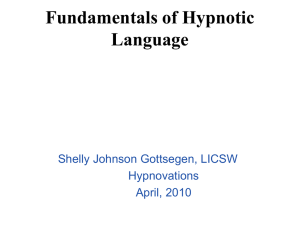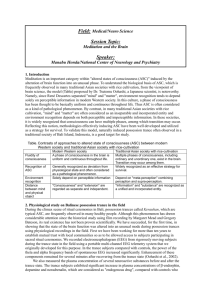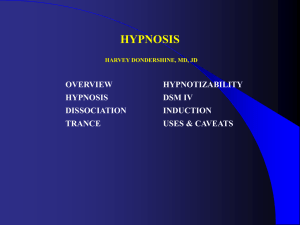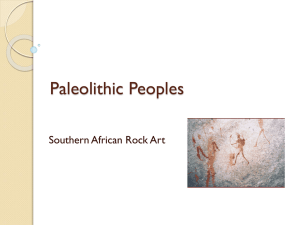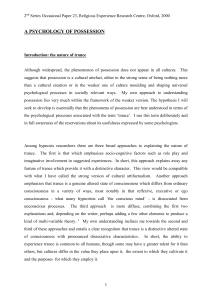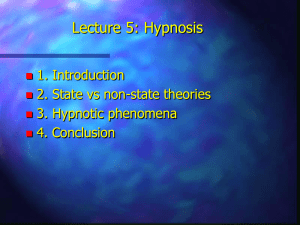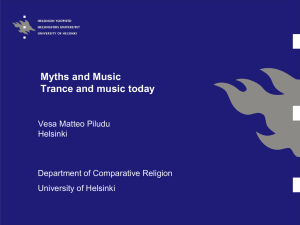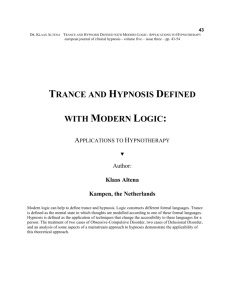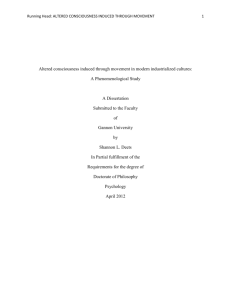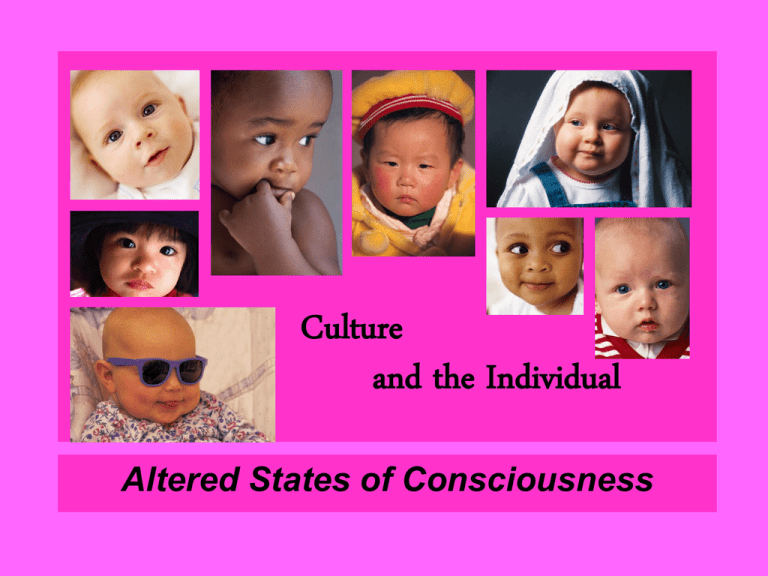
Culture
and the Individual
Altered States of Consciousness
Altered States of Consciousness
Definition: States of consciousness that are deviations from the normal
waking state, such as dreams, trances and hypnotic states
Normal states of consciousness include:
• awareness external stimuli
• awareness of internal stimuli
• awareness of self as having experiences
• awareness of thoughts about all of the above
Trance: state of low response to stimulus and diminished, narrow attention.
Dreams: a subconscious experience of a sequence of images, sounds, ideas,
emotions, or other sensations during sleep, especially REM sleep.
Hypnotic state: a trance-like state of intense concentration that, to an uninformed
observer, resembles sleep
Characteristics of Altered States of
Consciousness
• Distortions of perception
• Intense positive emotions
• A sense of unity with the world around
you
• Illogical
• Indescribable
• Transcendent (surpassing the usual
limits)
Ways of Altering Consciousnies
Trance is the term usually used to describe
an altered state of consciousness
Types of trance Include:
Hypnosis
Daydreams
Meditation
Drug Use
Religious Conversion
Intense sexual orgasm
Trances
• Ways of inducing trances
Hypnosis
Fever
Seizures (epilepsy)
Drumming
Dancing
Reduction of exteroperceptive stimulation
Reduction of motor activity, passive immobility
Fasting
Sensory bombardment
Hyperventilation
Drug states
Trance Videos
Bali, Indonesia
Buddhist Monkey Chant
Cappadocia, Turkey
Sufi Muslim Whirling Dervishes
Trance
• Society may provide special
roles for those who have trance
characteristics
• Society may teach trance
behaviors as the appropriate
way to contact the spirit world
• Trance movements may be
central to cultures
Trance
Trance specialists are intermediaries
who enter into trance states on
behalf of others
• Shamans
• Mediums
• Charismatic Leaders
Revitalization Movements
• A movement aimed at transforming
an entire culture
• Led by a religious prophet
• Usually a charismatic leader
• Frequently uses trance both in
individuals and groups as
transformative tool
Hypnosis
May require the help of a hypnotist to induce
a sense of trust
relaxation
focused concentration
suggested states of feeling or memory
Can accomplish:
Hypnotic hallucinations
Hypnotic age regressions (memory)
Hypnotic pain control
Depersonalization (out of body experiences)
Post hypnotic suggestions including amnesia
Can be induced in individuals and groups
Meditation
Buddhist Meditation
Relax and concentrate on breathing
Oral or silent mantras (repetition of sound or words with
special meanings)
Stress reducing
Changes brain activity
Compassionate Meditation changes
increases activity in the area of the brain that deals
with connectedness and caring for others
Changes in body states
Tibetan monks can raise their hand temperature by
altering the autonomic system to increase
circulation to the hands.
What is Possession?
Spiritual possession is when ghosts
(demons, devils, negative energies etc.)
control the
-mind (emotions, thoughts),
-intellect (decision making ability) and
-actions of a person
Aspects of Possession
•
•
•
•
•
•
•
•
Women are more often possessed than men
Publicly available idiom and system of communication
Publicly available system for production of social persons
In the here and now (women’s religions) rather than outside of the
here and now (men’s religions).
The possessed person becomes the spirit being (The spirit wears
the person’s body)
Possession is a public event in which questions, problems and
distress are given objective form and hence partially worked out in a
safe environment.
Spirits usually stick with the same person.
Spirits are frequently ancestors who come back to help the living
with everyday problems.
Hofriyat, Sudan, Africa
•
•
•
•
•
•
A Village of 500 Arabic speaking Muslims
Patrilineal descent
Circumcision defines a child’s sex and sets up gender roles
Women are minors by law, governed by male kin
Women are socially subordinate to men
Intrusions of powerful forces are most logically aimed at
women because they are vulnerable
• There are many ways a woman can fail
–
–
–
–
–
–
Divorce
Having a troubled marriage,
Husband taking another wife
Loss of a child
Never having children
Having fewer surviving male children
Janice Boddy
Zar Possession in Sudan
Who is possessed?
Married women
2/3 of all married women 35-55 years old
Once possessed, always possessed
Women who have headaches, stomachaches,
tiredness, anxiety, depression, loss of
appetite, etc. from stress
Zar possession in Sudan
Zar are spirits that possess women
• Trance is accomplished through drumming
• The spirits order the woman to take extra care of herself to provide a
good home for the spirit (food, perfumes, etc.)
• Women do all kinds of culturally forbidden things while possessed
and cannot be punished for their actions
• Possession provides women with a culturally sanctioned medium for
articulating distress
• Possession is not analysed merely in terms of its role in alleviating
social tensions or as a strategic game
• The possession is considered to be a real experience
• This experience is an important part of who a woman is – self
• Older women watch over the younger women who are possessed
and make sure they don’t come to harm.
Zar Possession in Sudan
Zar possession is lifelong and fundamentally
incurable
• The spirits who possess Hofriyati belong
only to foreign societies and epitomise all
that is not Hofriyati
• The possessed woman sees through the
eyes of the spirit into a normally invisible
parallel universe
• Everyday reality is made to appear as just
one of many realities
Korean Possession
• Occurs when women’s lives are in crisis or when
relationships conflicts
• Initial symptoms include fatigue, headaches, faintness,
diziness, aches, tightness in the chest, etc.
• Symptoms lead to release from family duties until
symptoms go away
• This cycle repeats
• Later symptoms include strange dreams or visions,
socially disruptive behavior, expression of resentment
and anger
• Woman is diagnosed with possession
• This diagnosis transforms the women into a Shaman
• Shaman are recognized and respected, paid for their
work
• This resolves many of the kinds of problems that
provoked the illness
Drug-Induced Trance Video
Venezuela, South America
Yanomamo Ebene Trances
Religious
Healing
Drug-Induced Trance
Australian Aborigines
Pituri Plant
Scopolamine and hyoscyamine alkaloids
Hallucinations
Illusions
Hunger and thirst
Used in initiation rites for males lasting 1 year
Rites include
Segregation of youth in isolated camps
Education about sacred matters by elders
Bodily operations such as circumcision
Disclosure of meanings for rituals and ritual objects
Final cleansing of all traces of the sacred world
Ceremonial return to ordinary life
Drug-Induced Trance
• Shangana-Tsonga, Mozambique, Africa
Datura fatuosa
Induces visions and auditory
hallucinations
Used at fertility for adolescent girls after
harvest
Used in conjunction with learning adult female
roles
Goal of the rituals is for the girls to hear the
voice of the fertility god and to see
patterns of green and blue animals and
plants.
Drug-Induced Trance
In all three societies drug trances were used to:
Heighten learning
Bond initiates to one another in their age-set
Subsume individual needs to those of the
group
Provide a metaphorical death and rebirth into
a new social status and role
Drug-Induced Trance
In all three societies the characteristics of the rituals
included:
Drug-induced hypersuggestibility of initiates
Management of altered state of consciousness by
adult tutors
Modeling of appropriate religious and secular
values and roles by tutors
Acquisition of new identity by initiates
Social recognition and respect for trance
experiences
Drugs used a sacraments providing entry into
valuable states of consciousness including
visions necessary for social function
Drug-Induced Trances
• Chumash Indians of California
Datura meteloides (jimson weed or toloache
Knowledge of the future, clairvoyance, visions
Used to help individuals find a spirit guide or
guardian spirit
Visions usually of animals who teach song or
dance
Some tribes use only once in a lifetime
Some tribes use as desired
Used with fasting, p;urging, dietary prohibitions,
abstinence from sex
Individually used by boys during initiation

